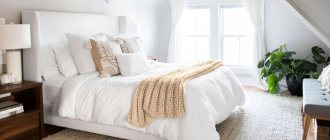03.12.2019
,
Placing a bed and sofa in the living room is a great way to economically distribute living space. The design of a studio apartment involves dividing the area into functional zones, while organizing sleeping and guest spaces. This becomes possible through the use of interesting design techniques.
How to arrange a living room with a sleeping place
When planning the furnishings when combining a living room and a bedroom, you must proceed from the area of the room. Actually, there are several ways.
One of the options for equipping a living room-bedroom in one room
- Do not delimit the space, but use transformable furniture. In particular, a bed built into a closet or a sofa bed, but not in the old version, but in the new one (one example is shown in the photo).
- Separate the space for the bed by separating it with a stationary or sliding partition.
- Separate the bed with a screen or curtains.
- Use furniture (wardrobe, shelves, etc.) for zoning.
One way to highlight the bedroom area in the living room is a partition, but not at full height
This is a view from the living room towards the bedroom
If the living room and bedroom are small (less than 16 square meters) or it is not possible to install a bed and sofa due to the layout, there is only one solution - to use transformable furniture. If the area allows, you can use any of the methods.
Choosing a sofa suitable for sleeping
Your restful sleep and healthy back will depend on the choice of upholstered furniture. Experts advise you to pay attention to the following criteria:
- Comfortable bed. The unfolded sofa should be free of bumps and depressions.
- Orthopedic filling of the base. The most expensive but effective option is a mattress with independent spring blocks. A spring block, combined with a layer of orthopene, latex or felt, is also suitable. Good filling is considered to be: rubber latex, periotek, holofiber. The main thing is not to buy furniture with a foam rubber base. The material becomes deformed from frequent use.
- Reliability of the transformation mechanism. Daily use requires a robust folding mechanism. The best mechanism is considered to be the “Eurobook”. “Dolphin”, “scissors”, “daytora”, “pantograph”, “accordion” serve for a long time.
- Durable frame. There will be no problems with a base made of solid wood, plywood or metal.
- Upholstery. It is worth choosing furniture with high-quality, durable, wear-resistant and easy-to-care material. For example, from jacquard, flock, chenille or cotton.
This range of colors is used in almost all styles.
Additional Information! It is better to choose a sofa whose length is 5 cm greater than the height of the person lying down. The minimum width for two is 1.4 m. More often you can find a convenient size of 2 m by 1.5 m.
For the effect of visual expansion of the area, you should choose light wallpaper.
When choosing furniture in a store, you should disassemble and assemble the sofa yourself, imagining that you do this every day. Then lie down and evaluate the comfort and the ratio of softness and hardness.
The choice of furniture is as important as the choice of wall color.
How to divide a room into zones
To decide whether you can have two separate zones in the room or not, you need to first evaluate everything on the plan. This can be done in design programs that allow you to obtain a two or even three-dimensional image. If working with programs does not seem attractive to you, you can get by with two sheets of thick paper or cardboard.
One of the programs...
To evaluate zoning options manually, you will need a floor plan with dimensions drawn to scale. Display on it where the windows and doors are located (also with dimensions). Next, you need to think about where you would like to place the bed, where is the sofa for guests. For the living room-bedroom, these are the two key items that they try to put first. It is better to cut them out of cardboard, and also to scale. You will also need to cut out from cardboard the furniture that is necessary and must be there. If you don't have one yet, cut them out in the sizes you want. Then you can make adjustments.
On paper it looks something like this
The resulting set of “furniture” can be moved according to the room plan, finding possible options for the location of zones. If there are several options, sketch, sign where and what you will put, putting down the dimensions of the furniture and the passages between them. Then it will be possible for everyone to think about what type of zoning can be applied in each option. The program works approximately the same way, only the movement is virtual. Using a program or layouts, you will understand whether you can select two separate zones, while determining the size of each of them. If it is not possible to separate separate zones, you will have to make do with folding furniture.
Solution for small rooms
Arranging small rooms requires a special approach. Creating an interior is an art, and the design of a small room, and even a multifunctional one, is generally akin to circus art. Even the little things are important here.
For a small living room bedroom you need to think through everything to the smallest detail
Let's start with what is considered a small room in this case. In general, it is believed that a room with an area of 14-16 meters is rather large. But in the case of the need to accommodate two zones - a living room and a bedroom - this is really very little. These are the types of rooms - up to 16 square meters - and we will accept them as small ones. If the area is 18-20 meters or more, these are already “normal” sizes in which the living room and bedroom can be divided using any zoning techniques.
Using customizable furniture
In a small room, it is not always possible to combine a living room and a bedroom, while installing a full-size bed. But you can always put a transformable sofa instead of a regular sofa. This is not a sofa bed on which you can only sleep conditionally. Modern transformable furniture can provide the same level of comfort as a regular stationary bed. There are models with orthopedic mattresses. Width ranges from single to full double.
Wardrobe that turns into a bed
Can be converted into a double bed:
- Closet. When closed, it looks like an ordinary wardrobe; it folds back and becomes a bed.
- Sofa. This type of furniture in the “day” position is similar to a sofa that stands near the closet; in the “night” position, the bed lowers, crushing the sofa under itself.
The options described above require a free space of at least 220-250 cm in front of the sofa or closet (depending on the model). And after the bed is in place, there should be at least a narrow passage left. So, in fact, the distance to the transformable furniture should be at least 280 cm. But you get a full-fledged double bed. The mattress can even be orthopedic.
This is an interesting transformation
There are also options for single or single beds. In them, the base of the bed is attached to the furniture with the long side. They require less free space - no more than 200 cm in the case of a one-and-a-half bed or 150 cm in the case of a single bed.
Unusual ways
There is one non-trivial option for how you can highlight the bedroom area in the living room: make a podium on which to place some area. There you can place, for example, several armchairs and a coffee table or place a sofa. Push the bed under the podium.
Make a podium and roll up a bed under it for the day (you can make a chest of drawers from the steps)
With this solution, the flooring must be of sufficient height so that the bed can be hidden under it. Long and narrow rooms, also called trailers, are ideal for this solution.
Another option for the young and active: move the bedroom to a closet. A square or rectangle of sufficient area to accommodate a sleeping place is assembled from cabinet furniture (high shelves, cabinets). You can do this using plasterboard partitions (as in the photo). On one side a staircase is built in/attached, along which one climbs up “to the bedroom”.
Here's an unusual way to separate the living room and bedroom
It turns out to be a living room-bedroom without reducing the living room area. You can even make the room even more multifunctional: arrange a workplace or mini-office in a space fenced off with furniture. This is an excellent option for a small studio apartment where young people live.
All this is not bad, but it is worth knowing about the disadvantages. First, the solutions are not cheap. Transformable furniture costs a lot, as does making a podium with sufficient load-bearing capacity. Secondly, every evening and every morning, in order to get and hide a sleeping place, you will have to make certain body movements. This only seems easy at first. In fact, it gets boring pretty quickly...until it becomes a habit.
Recommendations for arrangement
The area for receiving guests requires the installation of a sofa. Both straight and angular designs are suitable. The sofa is generally positioned with its back facing the bed. It is better to equip a small room with a folding sofa, a compact modular wall or a wardrobe with a mirrored front.
The living room can occupy space near the window opening. In this case, it is furnished with a pair of armchairs, a coffee table, a pouf, a console and a wall-mounted TV.
The sleeping area contains a bed with one or two bedside tables, a small chest of drawers or hanging shelves. If there is enough space, it is appropriate to add a dressing table or desk to the bedroom.
Choose a place for the sleeping area
When dividing rooms into a bedroom and a living room, first of all you need to decide where you want to make the bedroom. Most often, the corner farthest from the entrance is chosen. This makes sense, since the bedroom requires the greatest degree of privacy.
If there is a window in the separated area, you will have to make sure that there is enough light in the rest of the room. Glass partitions, separation using screens or curtains, specially created translucent shelves help with this.
The bed in the living room with a separate bedroom is usually placed further away from the entrance
In the opposite situation - if the window is in the living room area, the situation is slightly better. Firstly, the bedroom is usually used at night. So natural light is not such a necessity. Although we are accustomed to the fact that it should be. There are two solutions: make the division so that there is enough light or get what is missing by installing additional lamps.
Zoning the living room-bedroom with partitions
For zoning, partitions made of plasterboard and glass are used. The installation of both is not a redevelopment, so it does not require approval.
Not everyone likes the idea of putting a room divider. But it may not be whole. Very often, a “monolithic” partition is erected to a height of a meter or a little more, and above that they make something openwork that allows light to pass through. This solves the problem of natural lighting and the structure does not look as heavy as a wall.
Partitions - they are different
Also a good way to isolate a bed. Openwork things are made from plasterboard. Also an option.
The upper part can be designed in different ways. If you want physical separation, but without much loss of light, it could be patterned, frosted, colored glass. Do not be afraid that the glass partition is fragile - it can withstand loads greater than drywall.
Other options: various types of wood and metal products. There are a lot of options - from functional or decorative shelves, to pins made of wood, metal, bamboo, etc. simply installed in a certain order (or without it).
Basic ways to delimit space
There are several ways to zoning space, using:
- colors;
- textured surfaces;
- lighting;
- even indoor plants are put to use.
But most often, partitions and curtains are used.
Partitions
Partitions help divide a room without making the space feel cluttered. They can be:
- brick (for those who care about sound insulation and who want to get an almost complete room);
- made of plasterboard (these are installed on metal frames, covered with wallpaper or painted).
The first option is stronger, but it will no longer be possible to disassemble it; the second one is easily removed.
Reference
Another option is portable partitions. They consist of sections connected to each other with special fasteners. They are easy to disassemble and transport from place to place. There are partitions made of laminate or glass. They are eye-catching and functional, but they must be handled with special care.
Curtains
An economical and simple way to divide space into zones. This option has many advantages: in addition to small expenses, space is saved, curtains can be removed or replaced at any time, and also hide the flaws of an unsuccessful repair from prying eyes or hide its absence.
The following curtains are best suited:
- classic fabric (made of dense material, plain or with a pattern on both sides);
- light translucent tulle or silk (with the same pattern and texture);
- Japanese, resembling a partition in appearance (with expressive ornaments);
- fabric blinds;
- thread curtains (they transmit light well, do not visually burden the space, and are easy to clean);
- canvases made of beads (the color is selected to match the main color palette in the room, they are universal).
Attention
It is recommended to use organza, cotton, linen, jacquard, bamboo, and tulle as fabrics. For rooms whose windows receive light most of the day, translucent light curtains are suitable.
Separating zones with screens
You can create zoning in the living room and bedroom using screens. This is a quick and inexpensive way to zone the living room and bedroom in one room. Do not think that this method is outdated and irrelevant. If you choose the right textures, materials, colors, everything looks very stylish, original and appropriate.
Option for a translucent partition for zoning the living room and bedroom
A portable screen can be stylish
You can even use a rope curtain as a screen. The main thing is the visual delimitation of space Light mobile curtain
Openwork is good in classic interiors
There are traditional screens - portable, folding. But it is far from necessary that they have an “old-regime” appearance. No, traditional-type screens - covered with tapestries - are good for classic interiors. And those that come from the “sixties” - painted, made of wood and plywood - look great in a loft or art deco. If your living room or bedroom is decorated in this style, it will not be difficult for you to find the right option. But modern interiors require other materials and textures, and here you will have to try.
Glass screens
Glass screens are ideal for modern style, minimalism, and hi-tech. It’s just that you have to choose different glass. For hi-tech and minimalism, the best option is tinted with a silver coating, reminiscent of a mirror. White, milky, gray will look good - depending on the design of the bedroom-living room. A living room bedroom in Provence style can also be equipped with a screen made of painted plywood. But if you don’t like a too “rural” option, you can add a glass screen with photo printing. You can choose one of the landscapes that are typical for the south of France, use colored glass with floral patterns.
The frame is made of metal, the filling is frosted glass or sheet polycarbonate
Milk glass is opaque, but allows enough light to pass through
A look from the other side
Interesting option with patterned glass
Traditional glass sliding screen
Patterns are applied using a sandblaster
And again, don’t think that glass is fragile. For such products they use hardened or laminated (duplex and triplex), and they are stronger than many sheet materials.
From other materials
If you still don’t like glass, you can make or look for partitions made of plastic, wood, etc. You can make a wooden screen into a wooden house. If you know how to work with wood, this will not be difficult, since the design is simple. You can imitate a wall, you can make a lighter, openwork design. Again, everything depends on the style in which the living room and bedroom are decorated.
A patterned plastic partition visually separates zones from one another
The simplest wooden screen made of rods or planks
Carved wood panels require more skill
Metal openwork….
If wood is only found in some decorative items, frames are made from it, and the filling is selected according to your own taste. After all, it could be fabric. The same as on curtains or upholstery. You can use fiberboard laminated to match the furniture, plywood or thin chipboard. You can even assemble such a screen from drywall and cover it with wallpaper or paint it - it will be a movable wall.
For a modern style, you can use well-aimed branches painted in the main or one of the additional colors. They are attached to frames along or across to create a translucent screen. Bamboo, metal rods, etc. can be secured in the same way. In general, as usual in interior design, this is a creative process.
Sliding screens
A few more words about sliding screens. They are in a separate class, since they are not as “nailed into place” as stationary partitions, but also not as mobile as portable screens. A very good option for zoning the living room and bedroom into one room if you want to have a secluded corner for relaxation.
Sliding screens can be of three types. They can move like sliding doors, fold like a book or an accordion. For all of them, the bottom needs guides that are attached either to the ceiling, or to the floor, or to both the floor and the ceiling at the same time. Only screens with a bottom guide can not reach the ceiling, but they are the most unstable. If you have children or are not sure that you will use them carefully, it is better to use floor-to-ceiling models.
Sliding screens are made like compartment doors
Living room bedroom with separation of zones using sliding screens
With a slight touch of oriental style
Geometry always looks good
The material for screens of this type is any sheet: glass, plastic, laminated fiberboard, MDF. You can look for similar systems in companies that deal with sliding wardrobes. Doors for sliding wardrobes are made using the same system and partitions are no different.
Good color palette
By skillfully using colors, you can visually increase the area of the smallest room. An indispensable assistant - the colors of ceilings, walls, furniture. There are various ways in which colors influence reality:
- orange-yellow shades fill the interior with warmth;
- gray, brown, beige evoke comfort and tranquility;
- blue and light blue - expand the space;
- Green shades are calming and peaceful.
Bright colors create a feeling of space; the room will seem larger.
The listed options are ideal for a recreation area, because... their main function is to bring calm. But other facts must be taken into account:
- The sofa can become an accent detail of the interior. To do this, choose furniture with bright upholstery. Or cover the seat with a blanket in a rich neon color. In the evening, the bright detail can be covered with a neutral-colored blanket to relax and unwind a little.
- If the tone of the walls is light, a sofa with upholstery a couple of shades darker than the walls will look stylish.
- The classic option is upholstered furniture in pastel colors. For a teenager, a gray or brown sofa is suitable. For newlyweds or a young girl - olive, milky, creamy, white colors.
For this kind of room, light, pastel colors are more suitable.
Note! Wallpaper for the bedroom with a small pattern or geometric pattern will visually “pull apart” the walls.
A correctly selected color palette will make the interior irresistible.
Zoning with curtains
An even more inexpensive way is to have a living room/bedroom divided into zones by curtains. All that is required is to select and secure curtain rods. Then select fabrics and sew panels of the required sizes. The fabrics used are the same as for windows and they do not have to be thick, although this option is possible.
Curtains can be without folds - in the Japanese style. Draperies around the perimeter - to create coziness. Visible division
Double curtains - it is important to choose the right curtain rods
The drapery can cover only the “clearance”, or it can also go along the walls, creating a cozy atmosphere. But this option will still require quite a bit of money, since you need a lot of fabric.
Such zoning of the bedroom and living room combined in one room is nominal, but creates the required feeling of privacy. It can be used in the version with portable screens as a temporary option - if you just can’t decide where exactly to place the bedroom and living room areas, or how to distribute the area between them.
Using furniture to separate
It is not always possible to allocate even a small piece of space in a small room under a non-functional partition. Moreover, furniture can perform the same task. Usually this is a closet or high shelves.
Most often, the lower part of the furniture is made without gaps (about a meter high). I make this part in the form of a cabinet or chest of drawers. The top one is usually made with through gaps. This way the furniture doesn’t look so bulky and doesn’t “clog” the space. In addition, this solution allows you to maintain natural light in both parts of the room.
A cabinet or chest of drawers is made in the lower part, shelves are made above
Non-linear shape adds originality
A look from the other side
The main thing is not to clutter the shelves
When developing the concept of such furniture or looking for ready-made options, keep in mind that all horizontal surfaces collect dust well. Each shelf is a dust collector. If they are not planned to be used, it is better to make as few horizontal lines as possible. It is better to hang several decorative items in the spaces between the racks. They collect much less dust, and perhaps look more original.
Advantages and disadvantages
There are several positive and negative aspects of a bedroom combined with a living room.
| pros | Minuses |
| A great opportunity to create your own private space even in a small one-room apartment. | Insufficient level of sound insulation in the sleeping area. |
| Maximum efficient use of available space. | The combined bedroom is no longer as private as if it were located in a separate room. |
| The combined room creates an original and interesting design. | Interior design of a bedroom-living room requires a more thorough and serious approach. |
| Redevelopment of space requires permission for repairs from special organizations. |
Living room bedroom: additional zoning techniques
In addition to physical separation, zoning the living room-bedroom in one room can be done using:
- Changes in floor and ceiling levels. For example, the bedroom area can be raised a little, and to further emphasize the division, you can use different flooring. It can be the same in color, but different in texture or material. For example, lay laminate flooring in the living room area and carpet in the bedroom area. You can also use different colors.
Different wall colors are one of the means of zoning. So the living room and bedroom clearly have two parts with different purposes. Separation by color
The podium is not small... but it can be 5-10 cm high
- Decorate the walls with different colors. You can use wallpaper of two colors, but with the same texture, paint it in a different color, etc.
- Different texture of the walls. In the living room, for example, there is decorative plaster of the Venetian type, in the bedroom there is liquid wallpaper.
These techniques will also help you zone your living room. But when choosing colors, you must be guided by the principles of color compatibility. Then you will be able to create a harmonious interior.
In the style of minimalism
Bedroom - living room, decorated in a minimalist style, ideal for a small space. The minimalist style is designed to create a functional space with several zones. At the same time, the room will look spacious and bright.
Zoning a bedroom in a one-room apartment Source elnikova.com
The peculiarity of the style is as follows:
- Use of furniture with transformation function. Each piece of furniture can perform several tasks.
- Calm color scheme, consisting of two or three shades.
- The furniture has clear geometric shapes and lines, as well as smooth fronts. Glossy surfaces visually enlarge the room.
- A minimum number of furnishings are used in the room - only the most necessary.
- Textured surfaces of furniture and decoration serve as decor.
- Much attention is paid to natural and artificial lighting. Therefore, the windows are not draped with heavy curtains, but are equipped with modern blinds or roller blinds. In the bedroom area, if it is located near the window, you can use straight-cut plain thick curtains.
- Only natural materials are used in decoration - glass, wood, stone.
- The most preferred are white, beige, brick, ash and sand shades.
Zoning a one-room apartment with curtains Source dizainvfoto.ru
To make the minimalist style comfortable and functional, you should adhere to the following rules:
- When decorating a room, consider proportions.
- Use design techniques for zoning space.
- Remove excess furniture and decor.
- Provide maximum amount of natural light.
- Use a calm color scheme.
The minimalist style allows the use of furniture with glossy surfaces, glass and mirror elements. But carved decor should be abandoned - the surfaces should be smooth and even. Furniture facades are blank, without open shelves and glass doors.
A small partition between zones Source timeszp.com











